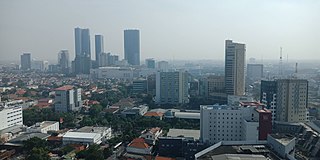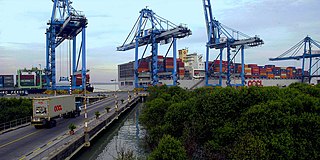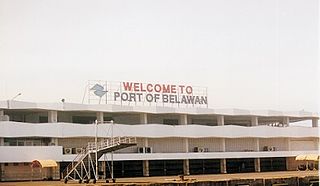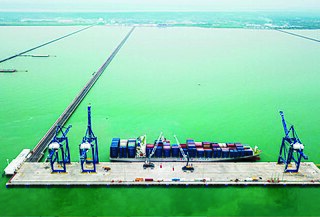
Surabaya is the capital city of the Indonesian province of East Java and the second-largest city in Indonesia, after Jakarta. Located on the northeastern corner of Java island, on the Madura Strait, it is one of the earliest port cities in Southeast Asia. According to the National Development Planning Agency, Surabaya is one of the four main central cities of Indonesia, alongside Jakarta, Medan, and Makassar. The city had a population of 2,874,314 within its city limits at the 2020 census and 9.9 million in the extended Surabaya metropolitan area, making it the second-largest metropolitan area in Indonesia. The official estimate as at mid 2022 was 2,987,863.

Port Klang is a town and the main gateway by sea into Malaysia. Known during colonial times as Port Swettenham but renamed Port Klang in July 1972, it is the largest port in the country. It is located about 6 kilometres (3.7 mi) southwest of the town of Klang, and 38 kilometres (24 mi) southwest of Kuala Lumpur.
Johor Port is a port in Pasir Gudang, Johor, Malaysia, built in 1977. It is an integrated multi-purpose port facility providing bulk cargo, container and general cargo services. It is the world's largest palm oil terminal and ranks third globally in terms of LME cargo volume.

Belawan is a harbor in Medan, North Sumatra. Located on the northeast coast of Sumatra, Belawan is Indonesia's busiest seaport outside of Java. It constitutes the most northerly of the city of Medan's 21 administrative districts (kecamatan), and covers an area of 29.44 km2; at the 2010 Census it had a population of 95,506.

Teluk Bayur formerly known as Emma Haven or Emmahaven is a port located in Bayur Bay of Padang city, West Sumatra, Indonesia. The port, the largest and busiest on the western coast of Sumatra, is operated by the government owned company PT. (Persero) Pelabuhan Indonesia II.

Tanjungbalai, also colloquially written as Tanjung Balai, is a city in North Sumatra province, Indonesia, on the estuary of the Asahan River. It has an area of 60.52 square kilometers (23.37 sq mi) and the sixth largest kota (urban) population in North Sumatra with 154,445 inhabitants in the 2010 census and 176,027 at the 2020 Census; the official estimate as at mid 2022 was 179,748. The town has a ferry terminal with services to Port Klang, Malaysia, and the city-island of Singapore.

Port of Tanjung Priok is the busiest and most advanced Indonesian seaport, handling more than 50% of Indonesia's trans-shipment cargo traffic. The port is located at Tanjung Priok, North Jakarta, which is operated by Indonesian state owned PT Pelindo. The port loaded and unloaded 6.2 million, 6.92 million, and 7.8 million TEUs of cargo during 2016, 2017 and 2018 respectively, out of a total capacity of about 8 million TEUs. The container port ranked as 22nd busiest in the world by Lloyd's One Hundred Ports 2019.

The Kali Mas is a distributary of the Brantas River in East Java, flowing north easterly towards the Madura Strait. This river also forms part of the border between the Sidoarjo and Gresik regencies.

Tanjung Priuk Station (TPK), is a railway station in Tanjung Priok, Tanjung Priok, North Jakarta. It is located across the Tanjung Priok Port, which is the main port of Jakarta. This station is one of the oldest in Jakarta and the biggest station built during the Dutch East Indies era. It is included in the list of heritage buildings by the government of Jakarta.

Port of Tanjung Emas is a seaport in Semarang, Indonesia. It is the seaport in Semarang, which is located about 5 km from Tugu Muda of the city center. It was constructed in the nineteenth century by the Dutch colonial government, for use in exporting sugar and various agricultural products coming from the hinterlands in Central Java, replacing a heavily silted, pre-colonial port. The port has been operated by Pelindo since 1985.

Port of Makassar, also known as Port of Soekarno-Hatta, is a seaport in Makassar, Indonesia. It has the highest passenger traffic among Indonesian ports and the largest cargo traffic in Sulawesi. It is considered a primary port by the Indonesian Government, along with the Port of Tanjung Priok (Jakarta), Port of Tanjung Perak (Surabaya), and Port of Belawan (Medan).

Patimban Deep Sea Port is a seaport at Subang Regency, West Java, Indonesia. It is located about 70 kilometers from the Karawang Industrial Estate and 145 kilometers from the city center of capital Jakarta, where many Japanese industrial firms, particularly automotive manufacturers operate. The port comprises a total area of 654 hectares in which 300 hectares will be specialized for intermodal containers and vehicle terminals while the remaining 354 hectares will be used as a back-up area. The port development is expected to be fully completed by 2027. The port operation was officially inaugurated by President Joko Widodo on 20 December 2020.
The Port of Krueng Geukueh, sometimes called the Port of Lhokseumawe, is a seaport in Aceh, Indonesia, located on the Strait of Malacca.

Port of Kuala Tanjung is a sea port at Batubara Regency, North Sumatra, Indonesia. Once fully functional the port can accommodate 60 million TEUs per year as the biggest port in West Indonesia, bigger than Port of Tanjung Priok in Jakarta. The first phase of development of Kuala Tanjung Multipurpose Terminal was inaugurated in 2018. The first ship to dock at the port was the cruise ship SuperStar Libra on 5 April 2018 from Port Klang, Malaysia. The port made its debut in the global container market, with its first shipment on 28 March, 2020.
Java Integrated Industrial and Ports Estate or JIIPE is an industrial area, integrated with deep sea port, residential estate and industrial area at Gresik, East Java, Indonesia. The project is located 24 km from Surabaya. It is a Public Private Partnership development, which is jointly developed by PT Usaha Era Pratama Nusantara, a subsidiary of PT AKR Corporindo Tbk, and PT Berlian Jasa Terminal Indonesia, a subsidiary of state owned company Pelindo III.
The Port of Tanjung Api-Api is a seaport in Banyuasin Regency, South Sumatra, Indonesia. Completed in 2007, it began passenger ferry operations to Muntok in 2013, and cargo operations in 2019.

The Port of Tanjung Kalian is a seaport located in the town of Muntok, in West Bangka Regency of the Bangka Belitung Islands, Indonesia. It serves as both a cargo port and a passenger ferry port, connecting the island of Bangka to Sumatra through the opposite Port of Tanjung Api-Api in South Sumatra.



















